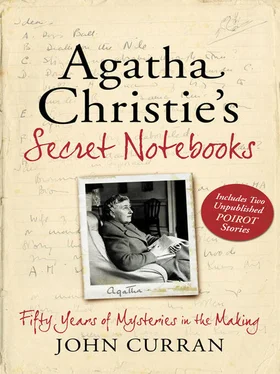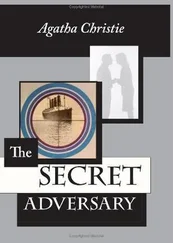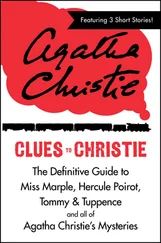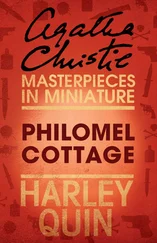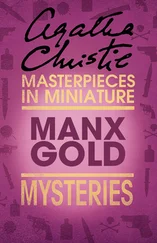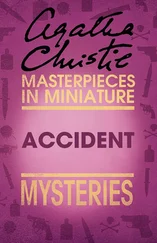Most of the characters were also settled from early on although, as happens with most titles, names were to change. Some were dropped altogether and replaced. I have indicated below the probable changes:
People on the plane
Mr Salvey and Mr Rider—Business acquaintances [James Ryder and, possibly, Daniel Clancy]
Mr Ryder Long—a dentist [Norman Gale]
Lady Carnforth—a gambler—husband won’t pay her debts [Countess of Horbury]
Jane Holt—a girl who has a humdrum career who has won a prize in the Irish Sweep [Jane Grey]
M. Duval—pere et fils—Archaeologists [the Duponts]
Venetia Carr (who wants to marry Carnforth) [Venetia Kerr]
James Leslie younger brother of Carnforth [possibly replaced completely by Dr. Bryant]
Madeleine Arneau—maid to Lady Carnforth [‘Madeleine’]
And during the subsequent investigation, the plot developments are observed, although not their final sequence:
Then Lady Carnforth—Japp and P—P stays behind and gets her to suggest his staying behind—tells her the truth and frightens her [Chapter 19]
Venetia Carr—P and J?—P plays on her dislike of Lady C [apart from a brief appearance in Chapter 12 Venetia Kerr does not feature again]
Mr Ryder—all fairly straightforward—business difficulties etc. [Chapter 18]
The Duponts—M. Dupont is to lecture at Antiquarian Society but perhaps they see them in Paris [Chapter 22]
Bryant—Japp interviews him—P goes as patient—may be a drug supplier—or someone who has done an Illegal operation—or guilty of non-professional conduct [Chapter 20/23]
Clancy—received the little man very hospitably—very chatty [Chapter 15]
An odd point about the interrogation of witnesses is that Venetia Kerr is not questioned either by Poirot or any of his fellow-investigators. Note also her address—Little Paddocks, 15 years later the scene of a dramatic murder in A Murder is Announced. And the subterfuge adopted by the Countess of Horbury to disguise her cocaine—labelling it ‘Boracic powder’—is the same as that adopted by the criminal 20 years later in Hickory Dickory Dock.
With her customary plot fertility, Christie came up with a few possibilities for Gale’s partner in crime:
Motive
Inheritance of money by daughter Anne
A. Anne is Jane Holt—Jane Holt and Angell [Norman Gale] plan the murder
B. Anne is Jane Holt—she is unaware of this—but Angell determines to marry her
C. Angele Morisot is Anne—she is in it with Angell—creates disturbance by coming in and speaking to her mistress at moment of murder—also gives damaging evidence against her
D. Angele Morisot is Anne—but is not guilty—she is engaged to Angell but never sees him on liner. He gets engaged to her under a false name—James Clare—a novelist—has a flat in London
E. Real False Angele Morisot presents herself with full proofs of identity to recover fortune (Real one Jane)
The most striking is the idea of Jane Grey as a fellow criminal, which would have provided an attractive surprise element. It was however abandoned in favour of the maid, and Idea C was utilised.
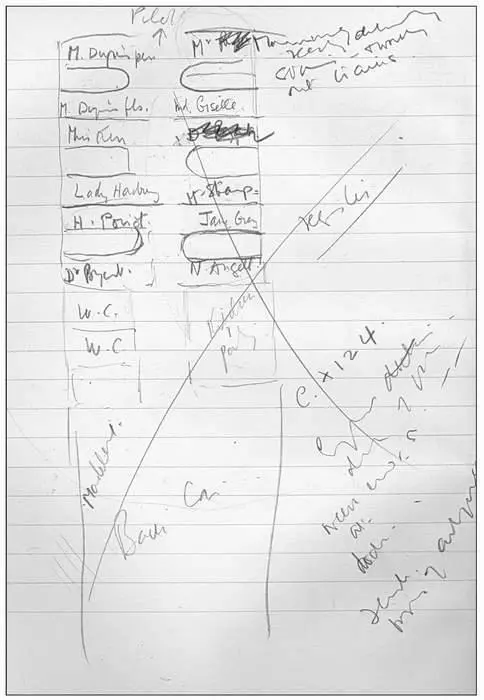
These sketches from consecutive pages of Notebook 66 show great attention to detail during the plotting of Death in the Clouds. Vitally, Norman Angell’s seat in the earliest two sketches is beside the WCs…
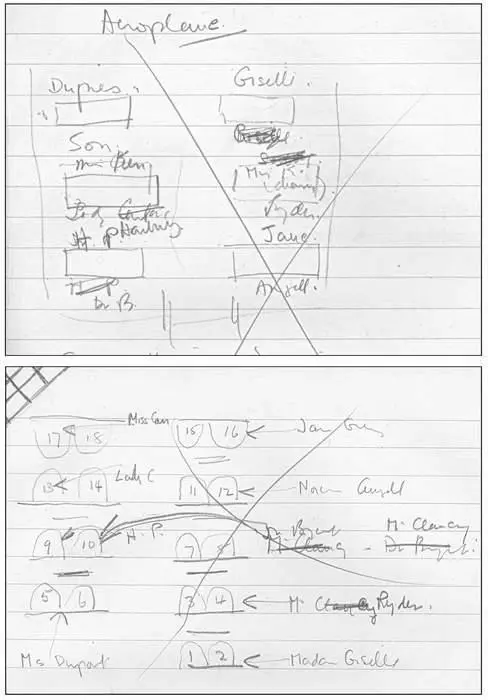
… but he is subsequently moved to the opposite end of the cabin, as dictated by the plot. Note the inclusion of the pilot’s cabin, the kitchen and pantry, the WCs, and the fact that some seats face each other.
The notes stop at Chapter 16, although the chapters in the notes do not correspond exactly to those in the novel. And, oddly, Norman Gale is never actually named in the notes as the killer.
The notes for Death in the Clouds feature diagrams illustrating the disposition of the passengers in the plane seats. Both from these and the novel as a whole, it can be seen that the interior of a plane cabin in the 1930s was very different to that of a modern plane. There are only 18 seats and a mere 11 passengers and of the possible nine aisle seats, only two are occupied. And a feature common to all three sketches is the arrangement of Jane and Angell (as Norman
Death in the Clouds depends for its effectiveness, both as a murder method and a detective novel, on a tactic that has come in for adverse criticism. The accusation of snobbery has been levelled because the killer, and by extension the author, takes it for granted that ‘nobody looks at a servant’. This ploy is also a feature, to a greater or lesser degree and sometimes with a twist, in Three Act Tragedy, After the Funeral, Appointment with Death, The Mystery of the Blue Train, Sparkling Cyanide and One, Two, Buckle my Shoe. Christie somewhat defuses this accusation with the following exchange from Chapter 24 ii of After the Funeral:
‘I ought to have seen it sooner—I felt in a vague kind of way I had seen you before somewhere—but of course one never looks much at—’ He stopped.
‘No, one doesn’t bother to look at a mere companionhelp…a drudge, a domestic drudge! Almost a servant.’
Gale was known at that stage). They are always shown sitting opposite each other in window seats, away from the aisle, as dictated by the plot. The chances of Gale being identified on his admittedly daring walk through the plane on the way to and from his commission of the crime are remote; as he reasonably guessed, Jane was likely to spend the interim checking her appearance. A greater danger, and one that has not been commented upon, was from the other stewards. It was much more likely that they would have spotted an ‘extra’ steward.
‘Problem at Sea’ February 1936
Mrs Clapperton is found dead in her cabin during a holiday cruise and Poirot’s solution depends on his most unusual witness ever.
The first note for this story appears in Notebook 66 and is dated January 1935, a year before publication. The elaboration later in the same Notebook includes much of the detail of the completed story:
Ventriloquist—on boat…Col C. very good with cards—says he has been on music hall stage etc. Wife dies in cabin but her voice heard inside after she has been killed
Man tells steward to lock cabin—body already inside—later comes back and Cabin lock Calls to wife—she answers apparently (ventriloquist). Hypodermic beside her—and pricks on her bare arm
One point of difference between the notes and the finished story is that the hypodermic as a murder method is replaced by stabbing. While the ventriloquism idea is a clever one it would not have carried a novel and Christie was right to use it only for a short story.
Death on the Nile (novel) 1 November 1937
When Simon Doyle marries wealthy Linnet Ridgeway, and not Jacqueline de Bellefort, the consequent train of events culminates in triple murder aboard a Nile steamer. Hercule Poirot, also travelling on SS Karnak, has observed the tragedy unfolding and investigates one of his most famous cases.
Although published late in 1937, this classic Poirot title was written up to two years earlier. A letter from Edmund Cork dated 29 April 1936 expressed delight at Christie’s news that Death on the Nile was finished. Unfortunately, there is no Notebook with notes for the plot of this famous title. We do, however, have, in Notebook 30, a list of potential characters—including one very significant one—and a brief note about possible plot development. Most of the ideas originally intended for inclusion were waylaid into other titles.
Читать дальше
Конец ознакомительного отрывка
Купить книгу
